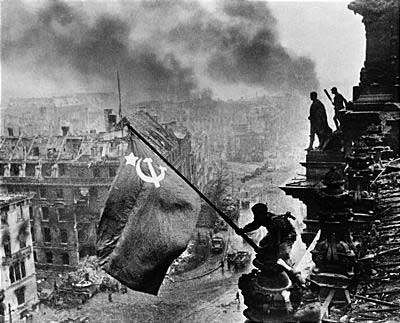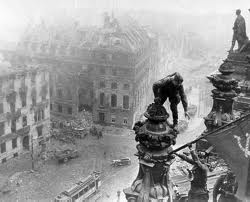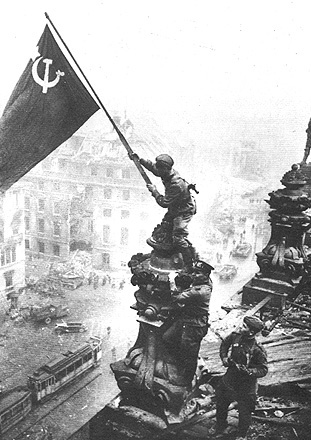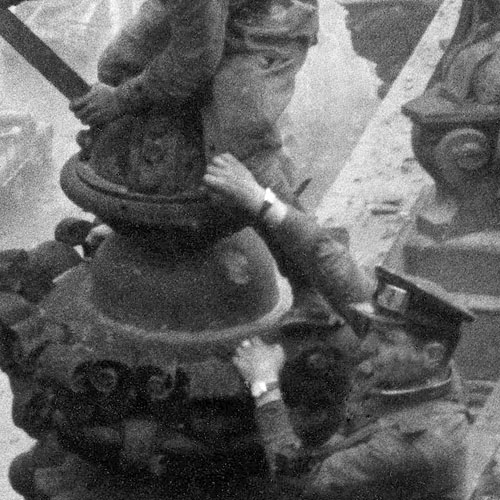Image: Hammer and Sickle Time on the Reichstag July 9, 2013
Author: Beach Combing | in : Contemporary , trackback
Yevgeny Khaldei (obit 1997) was Jewish, a Ukrainian and a Soviet citizen: three pretty good reasons to hate the Third Reich. A talented photographer he must have counted himself lucky, then, to have been in at the kill, on the roof of the Reichstag as an adolescent, Aleskei Kovalyev, lifted the dreadful flag of Stalin over a destroyed city, 2 May 1945. Berliners had a very unpleasant fortnight ahead of them: in fact, most of them would have a pretty horrible forty years. 

Khaldei had no idea what the future held, of course, but he took one of the great shots of the twentieth century, the photograph that came to represent victory in Europe for the western allies and revenge for the burghers of Moscow and Stalingrad. The shot itself was taken with Iwo Jima in the back of Khaldei’s and, indeed, his superiors’ minds: the Soviets had made four attempts to plant a flag on the Reichstag, two successful, one taken down by the Germans, by the time that Khaldei and this particular group got there. Khaldei, in fact, grabbed a few soldiers at the base of the building, explaining that he needed help in staging a shot. The parallel with Iwo Jima extend to the artificial way in which the photograph was taken, then.

The range of pres and posts here show the flag going up and the careful balancing as the young Aleskei (another Ukrainian) tries not to tumble over into the streets below. But as interesting was the photoshopping that went on afterwards. Khaldei, first of all, had to do something about the ‘watches’ that appeared on the wrists of the officer supporting Aleskei: the people of the world might come to the base conclusion that the Soviet army was looting the enemy! Of course, the Soviet army was looting the enemy (and raping and murdering…) on an unprecedented scale, but a photograph of a Soviet photographer had to represent Soviet ideals. (See a previous post about Soviet photo alteration and an absurd argument about shoes.) So Khaldei scratched out the watch on the man’s right wrist on the negative using a needle: the ‘watch’ may, in any case, have been a compass. He also added some smoke to the city scape, though being 2 May there was quite a lot of that around already.
Khaldei’s name was only attached to the shot post 1991. His larger achievement as a fine war photographer, in fact, was celebrated with international exhibitions in the years immediately prior to his death but not before. This is a shame as he took some fabulous pictures.
Any other great historical photographs with backstories? drbeachcombing AT yahoo DOT com
Beach found himself, while writing this, full of sorrow for the brave Soviet soldiers fighting monsters and led by monsters and recalled this Waterboys song from a decade or two ago: When I left my home and my family/ My mother said to me/ Son, its not how many Germans you kill that counts/ Its how many people you set free… [!]
27 April 2014: JJ writes: This passage comes from Andrew Roberts (I think, excellent) Storm of War and gives some of the back story: ‘The famous photograph of the red flag being waved over the Reichstag in 1945 was taken by the twenty-eight-year-old Ukrainian Jew Yevgenny Khaldei with a Leica camera. The flag was actually one of three red tablecloths that the photographer had, in his words, ‘got from Grisha, the bloke in charge of the stores at work. He made me promise to bring them back.’ The night before he left Moscow for Berlin, Khaldei and a tailor friend of his father’s had ‘spent all night cutting out hammers and sickles and sewing them onto the cloths to make Soviet flags.’ It was thus a tablecloth that was flown, somewhat precariously, over the devastated Berlin that day. ‘What do you mean, you left it on the Reichstag?’ Grisha cried when Khaldei explained to him what had happened. ‘Now you’re really going to get me into trouble!’ The Tass picture editor spotted that the young soldier, ‘a boy from Dagestan’, who was propping up his flag-waving comrade, had watches on both wrists, clear indication of Red Army looting, and he made Khaldei airbrush that detail out of the photo.’ Thanks JJ!



